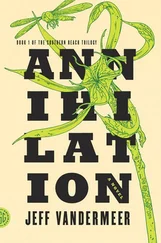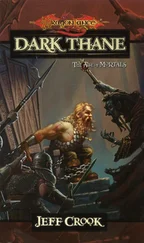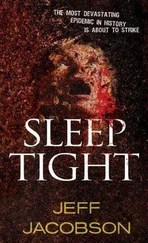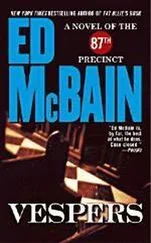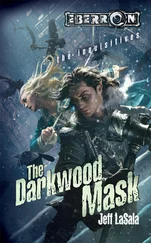Jeff Rovin - Vespers
Здесь есть возможность читать онлайн «Jeff Rovin - Vespers» весь текст электронной книги совершенно бесплатно (целиком полную версию без сокращений). В некоторых случаях можно слушать аудио, скачать через торрент в формате fb2 и присутствует краткое содержание. Жанр: Триллер, на английском языке. Описание произведения, (предисловие) а так же отзывы посетителей доступны на портале библиотеки ЛибКат.
- Название:Vespers
- Автор:
- Жанр:
- Год:неизвестен
- ISBN:нет данных
- Рейтинг книги:5 / 5. Голосов: 1
-
Избранное:Добавить в избранное
- Отзывы:
-
Ваша оценка:
- 100
- 1
- 2
- 3
- 4
- 5
Vespers: краткое содержание, описание и аннотация
Предлагаем к чтению аннотацию, описание, краткое содержание или предисловие (зависит от того, что написал сам автор книги «Vespers»). Если вы не нашли необходимую информацию о книге — напишите в комментариях, мы постараемся отыскать её.
Vicious bat attacks moving southward along the Hudson River prompt Nancy Joyce, a bat scientist who works for the Bronx Zoo, to investigate. When the attacks move into the New York subway system, Manhattan police detective Robert Gentry becomes involved. Joyce and Gentry team up to determine what is causing this unusual behavior. What they discover will keep listeners pinned to their seats and clawing for more.
Vespers — читать онлайн бесплатно полную книгу (весь текст) целиком
Ниже представлен текст книги, разбитый по страницам. Система сохранения места последней прочитанной страницы, позволяет с удобством читать онлайн бесплатно книгу «Vespers», без необходимости каждый раз заново искать на чём Вы остановились. Поставьте закладку, и сможете в любой момент перейти на страницу, на которой закончили чтение.
Интервал:
Закладка:
Thirty-Five
They were too late.
Several police cars and fire trucks were pulled up in front of the three-story center for abused women. The cars were parked on the sidewalk so police and firefighters could get inside without being exposed to the bats outside for very long. A hose hooked to a fire hydrant had been used to douse the bats inside while the women and children were evacuated into ESU recovery vans. Once the bats were down, police officers with heavy-duty vests and helmets kept them down permanently using shovels. Deeper inside the building, police were using pressurized water extinguishers to knock the creatures from the air. When word came through that all the visitors and staff had been evacuated and accounted for, the officers had begun using scatterguns on the doused bats.
The giant bat had left shortly before the first police car had arrived. Around that time, the police reported, all the bats in the area had ceased their aggressive behavior, including bats that had gotten inside the shelter. They appeared frantic and disoriented but were nonviolent. Reports from other precincts indicated that the bats had calmed down all across Manhattan and were being exterminated by any and every means possible.
While Gentry headed into assist the other officers, Joyce hurried toward the vans to talk to the evacuees.
Up and down Twenty-third Street, New Yorkers were literally trying to get back on their feet. Those who could walk were helping those who could not. Many people were just sitting where they’d fallen, staring. Joyce imagined that the same scene was being repeated everywhere from Eighty-first Street to wherever the bat was nesting.
That, and the quiet. There were occasional shouts for help and moans of pain. But the fact that they could be heard only emphasized the silence that had settled on the city. There were no cars or growling buses, no air traffic, no bicyclists shouting for people to make way. There were no car radios or boom boxes, no loud conversations or kids shouting to other kids or the rattling coin cups of the homeless. There was no construction, no one selling hot watches from a briefcase or bundles of socks from a cardboard box. Save for the countless sirens and alarms, the stillness was abnormal, like during a blizzard.
New York sounded like Nancy felt. Numb. She still couldn’t believe what had happened back at the museum, that Professor Lowery was dead. She was glad she had these interviews to do, the problem of finding and destroying the bat to wrestle with.
According to the only adult eyewitness, a woman who had been in the playroom with several children, the creature had come through a skylight on the top floor and went right to that room. The woman said that while she crouched with the kids in a corner, trying to protect them but fully expecting to die, the bat ignored them all. She said that after looking around the room for several moments, the bat spread its wings, knocking over furniture and shelves. Then it wailed loudly, returned to the hallway, and flew back through the skylight. It was in the shelter for less than a minute.
One of the children, a young boy named Chaka, got up from one of the benches inside the van. He walked over to Joyce and said that the bat looked mean but wasn’t mean.
“That’s a pretty silly way to be, isn’t it?” Joyce asked. She took his hand.
“You’re cold,” he said.
“Very cold. I got sprinkled on.”
“How?”
“Water was putting out a fire. And I forgot my umbrella.”
Chaka smiled.
“Can you tell me a little more about the bat?” Joyce asked.
“It’s big.”
“It is. But it didn’t hurt anyone?”
Chaka shook his head.
A little girl from one of the benches said, “It reminded me of Oscar the Grouch.”
Joyce looked at the petite blonde. “Let’s see. That’s one of the Muppets fromSesame Street, isn’t it?”
She nodded.
Chaka said, “It looked mean, but it didn’t do anything bad to anyone. It just looked sad.”
Joyce thanked him, thanked everyone, then left the van. She chewed on the problem as she walked toward the town-house.
The bat hadn’t come to feed. She hadn’t come to give birth. But she had left the subway searching forsomething and wailed or wept when she didn’t get it.
What?
Joyce hoped the answer was in the playroom.
She walked inside. Dead, hurt, or unconscious bats were being swept aside with brooms. She made her way carefully down the wet corridor to the stairs in the back. On the third floor, she found herself standing under the shattered skylight. The playroom was directly ahead. She walked in.
The room smelled of wet fur. There were crushed toys and snacks, an upended TV, tattered sleeping bags, and overturned racks of videotapes and video games. Joyce stood with her hands on her hips, looking around.
Gentry walked in a minute later. “I think we got most of the bats,” he announced. “The cops’re shoveling them into Hefty bags. How were the people you talked to?”
“Pretty shaken up. Are you sure everyone is safe? No one’s missing?”
“Not a one,” Gentry said. “I talked to the police downstairs. The two ESU officers at the Twenty-third Street stop got knocked silly when she burned through the station and flew up the stairs, but she didn’t attack them.”
Joyce shook her head. “Then I just don’t understand.”
“Maybe she was conserving her strength. Maybe I hurt her when I fired those rounds back at the museum, and she came up to rest, get some fresh air.”
“She would have rested in the subway tunnel,” Joyce said. “Besides, there’s no blood.”
Gentry looked around. “So I didn’t even hit her freakin’ tail!”
“No,” Joyce said. “You didn’t. You only scared the bat off and saved my life. What was it you said to me back in the car? About asking too much of yourself?”
“I saidyou shouldn’t. I can, though.”
“Right.” Joyce knew he was joking but not. She let it go for now. She continued pacing in a circle as she looked around the room. The sleeping bags were ripped where the bat had walked across them. A few videocassettes had been crushed, and the TV was blank.
“So what do you think?” Gentry asked.
“I don’t know. I just don’t know.”
“How do I start thinking like a bat?”
“You ask yourself what sensory input could have brought you here,” she said. “All right. Let’s go back. The bat left the museum and entered the subway. She got down here fast, which meant she had to be flying. Flying and echolocating because the subway tunnels are a snug fit and she’d have to watch out for girders and posts. She probably intended to stay underground until she reached her nest.”
“Maybe she came out to eat.”
“Unlikely.”
“What makes you so sure?”
“Because shedidn’t eat. She didn’t attack the police at the station stop or the people here. Besides, if she were hungry she would have waited until she was closer to home. Less distance to carry her meal. No. As she neared here she either heard or smelled something that made her leave the subway. She flew straight to the roof and came down through the skylight. Then she entered the playroom. She attacked no one but encountered something here that made her cry again.”
“Wait. Again?”
Joyce nodded. “The bat also cried when she realized that her mate was dead.”
“You mean she cried like a human being?”
“I believe that’s exactly what it was, yes. Of course, that grew into rage back at the museum and caused the other bats to go berserk. But not here. She left without hurting anyone. Why?”
“What were the kids doing?” Gentry asked.
Joyce was still walking around the room. “Coloring, reading, resting, snacking.” She looked down at a half-eaten peanut butter sandwich, an overturned container of milk, a banana. The bat hadn’t touched any of the food.
Читать дальшеИнтервал:
Закладка:
Похожие книги на «Vespers»
Представляем Вашему вниманию похожие книги на «Vespers» списком для выбора. Мы отобрали схожую по названию и смыслу литературу в надежде предоставить читателям больше вариантов отыскать новые, интересные, ещё непрочитанные произведения.
Обсуждение, отзывы о книге «Vespers» и просто собственные мнения читателей. Оставьте ваши комментарии, напишите, что Вы думаете о произведении, его смысле или главных героях. Укажите что конкретно понравилось, а что нет, и почему Вы так считаете.

